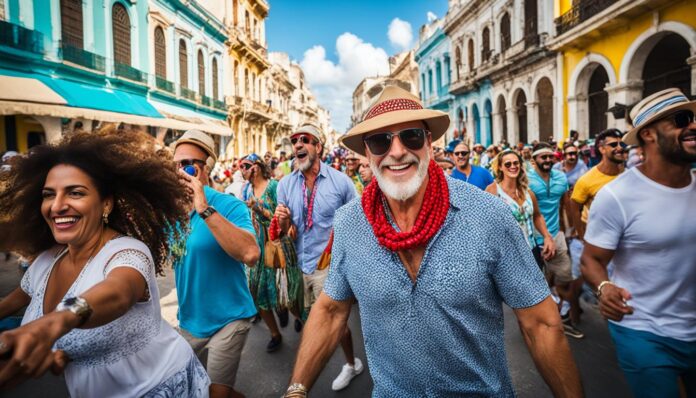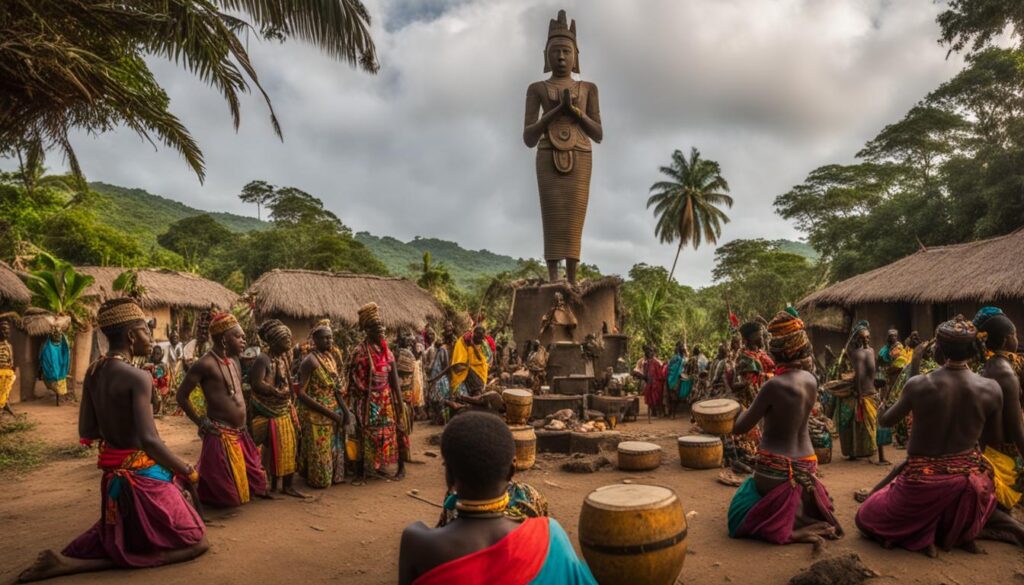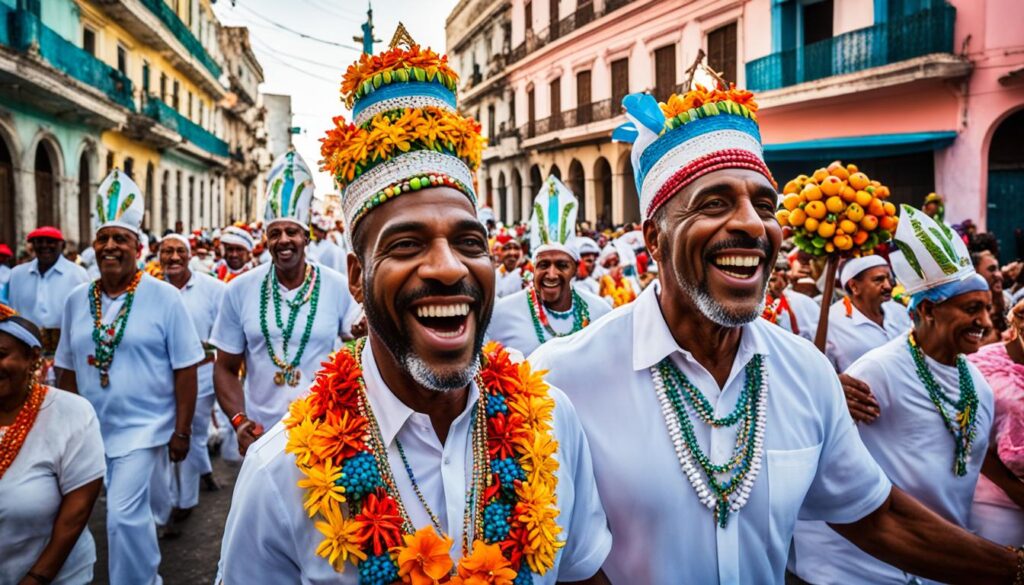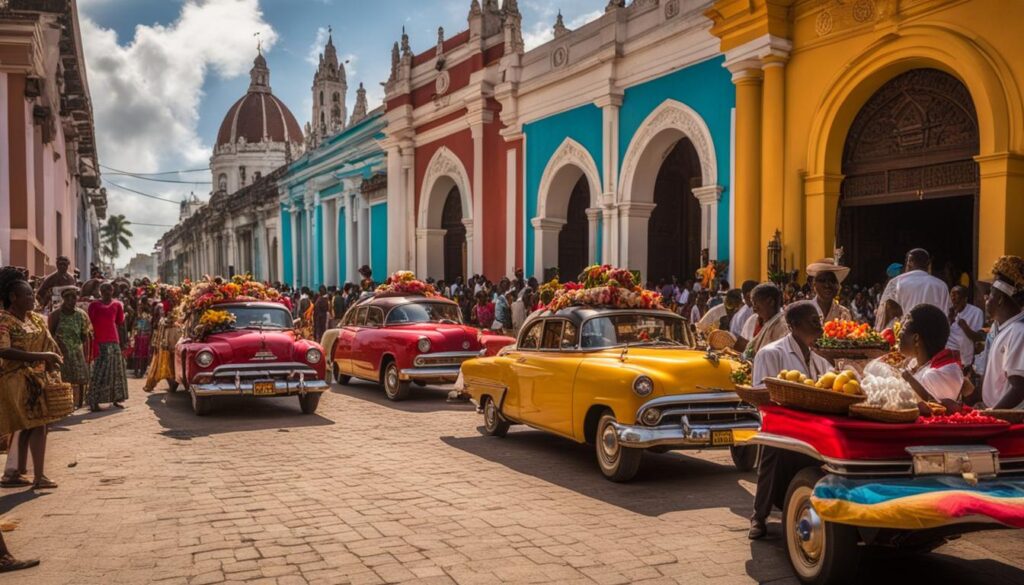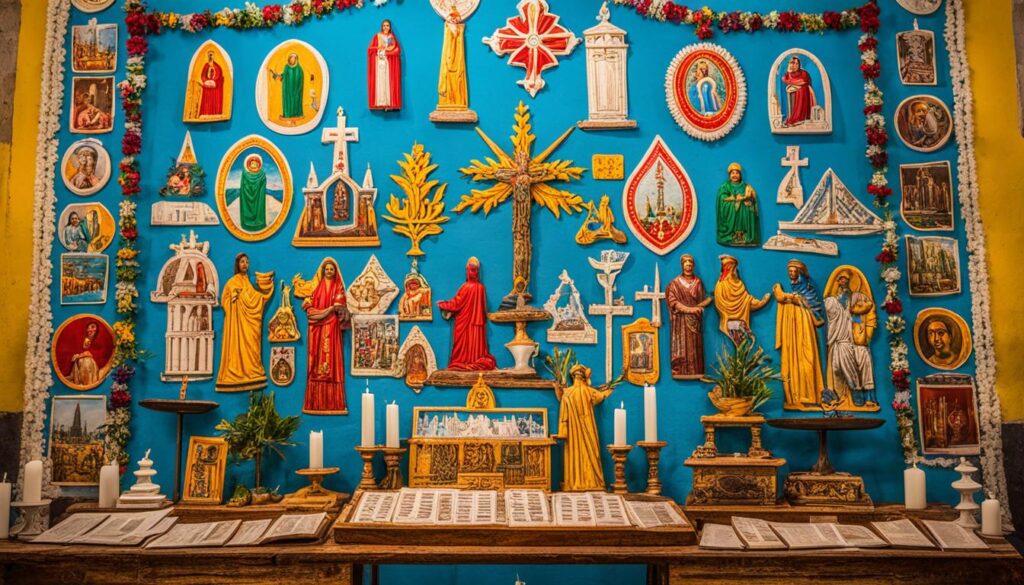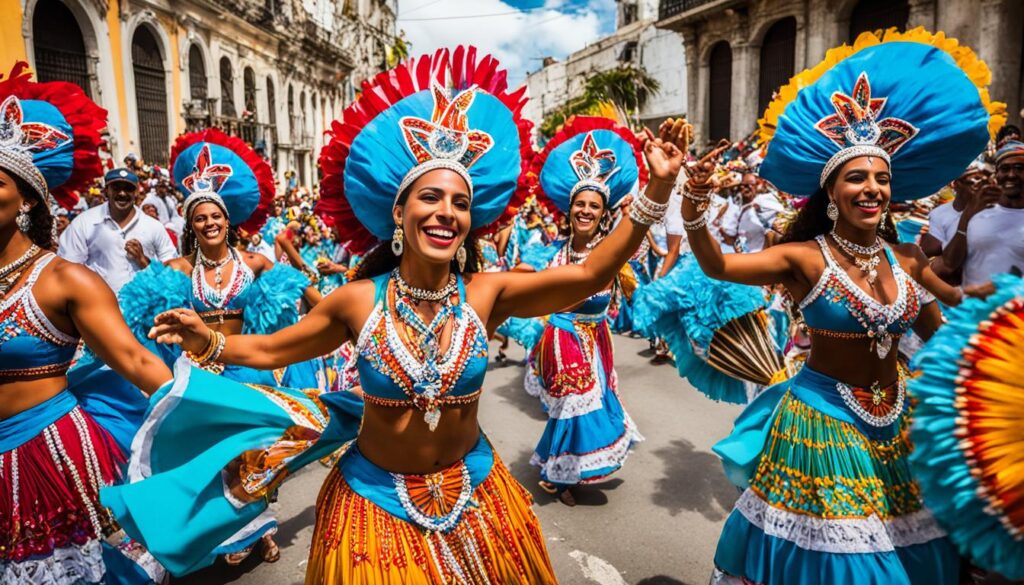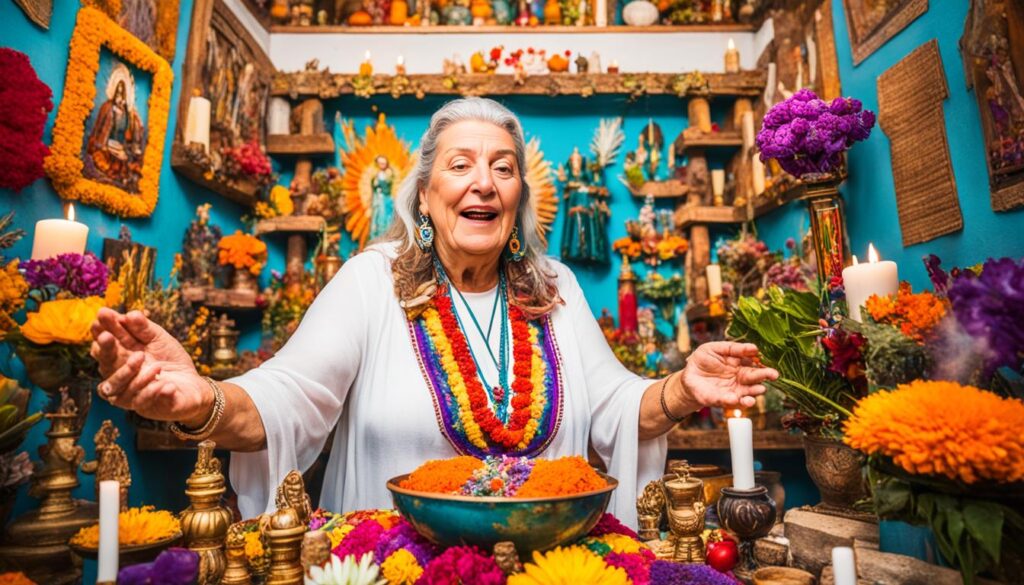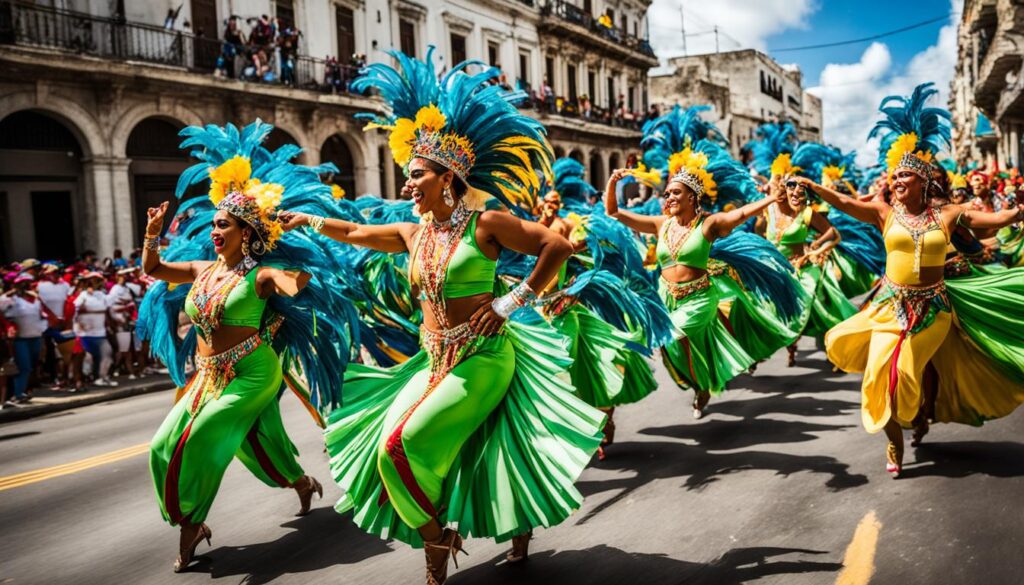Have you ever wondered about the cultural heritage and religious practices that shape Havana, Cuba? Explore the captivating world of Havana’s Afro-Cuban religious traditions and delve into its cultural tapestry. From the vibrant rituals to the diverse religious beliefs, Havana offers a glimpse into a spiritual realm that will leave you in awe.
Immerse yourself in the rich history and heritage of Havana as we uncover the origins of Afro-Cuban religions and their evolution over time. Challenge your beliefs and uncover the influence of Yoruba tradition on Afro-Cuban religions in Cuba. Discover the significance of Santeria in Havana and its rituals that connect the spiritual and human realms.
But that’s not all, Havana’s religious diversity goes beyond Afro-Cuban traditions. Explore the harmonious coexistence of various faiths and their impact on the local community. Uncover the rituals and ceremonies that form an integral part of Afro-Cuban religious practices, and learn about the efforts to preserve and celebrate these traditions in Havana.
So, are you ready to embark on an extraordinary journey of cultural exploration and spiritual discovery? Join us as we uncover the fascinating Afro-Cuban religious roots that shape Havana’s vibrant cultural tapestry.
The Origins of Afro-Cuban Religions
Discover the fascinating origins of Afro-Cuban religions and witness their evolutionary journey over time. These unique religious practices have emerged as a blend of African and Spanish influences, forming an integral part of Cuban spirituality.
“The spiritual traditions of Afro-Cuban religions are deeply rooted in the cultural history of the island. They are a remarkable fusion of African and Spanish beliefs, reflecting the complex tapestry of Cuba’s diverse heritage.”
Afro-Cuban religions trace their beginnings to the arrival of African slaves in Cuba during the colonial era. These enslaved Africans brought with them their rich spiritual traditions and cultures, which merged with the Catholicism imposed upon them by Spanish colonizers. The result was a syncretic fusion of African and Catholic beliefs, giving rise to Afro-Cuban religious practices.
As Africans were forced to abandon their ancestral religions, they adopted symbols, rituals, and deities from Catholicism to disguise their indigenous practices. This blending of African and Spanish traditions laid the foundation for religions such as Santeria, Palo Monte, and Abakua.
Today, Afro-Cuban religions continue to thrive in Cuba, serving as an essential aspect of the country’s cultural and religious identity. These traditions have evolved and been preserved through generations, adapting to changing times while maintaining their core beliefs and practices.
The African Influence
The African influence in Afro-Cuban religions can be traced back to the diverse ethnic groups that were brought to Cuba as slaves. Each group contributed its distinct traditions, rituals, and deities, creating a vibrant mosaic of spiritual practices within the Afro-Cuban religious landscape.
Yoruba traditions from West Africa, in particular, played a significant role in shaping Afro-Cuban religions. The Yoruba people brought with them their belief in Orishas (divine deities) and initiated rituals such as divination and ancestral worship. These practices became deeply integrated into the fabric of Afro-Cuban traditions.
The influence of Congo, Dahomey, and other African regions further enriched Afro-Cuban religions. Each group brought its own unique customs, folklore, and spiritual practices, which amalgamated with existing belief systems in Cuba.
The Spanish Influence
Spanish colonization introduced Catholicism to Cuba, providing the framework for the syncretic nature of Afro-Cuban religions. African slaves were forced to adopt Catholic beliefs and practices, resulting in a blending of Catholic saints with African deities.
This fusion allowed slaves to preserve their traditional faiths while outwardly appearing to follow Catholicism. Each Catholic saint became associated with an Orisha, creating a parallel system of worship that kept Afro-Cuban religions alive despite the oppressive conditions.
Today, Afro-Cuban religious practices honor a pantheon of revered deities, blending both African and Catholic elements. The worship of Orishas and ancestral spirits, along with rituals involving music, dance, and offerings, are central to Afro-Cuban religious ceremonies.
| African Influences | Spanish Influences |
|---|---|
| Yoruba traditions | Catholicism |
| Congo spiritual practices | Saints associated with Orishas |
| Dahomey customs | Worship of ancestral spirits |
This table illustrates the key African and Spanish influences that have shaped Afro-Cuban religions, showcasing the rich tapestry of beliefs and practices.
Santeria: A Pillar of Cuban Religious Practices
When exploring the vibrant landscape of Cuban religious practices in Havana, one cannot overlook the significance of Santeria. Deeply rooted in Afro-Cuban traditions, Santeria has emerged as one of the most prominent and influential religions in the country. Syncretizing elements of Yoruba spirituality with Catholicism, Santeria embodies a unique fusion of cultures and beliefs.
At the heart of Santeria lies a pantheon of deities known as Orishas. These powerful entities serve as intermediaries between humans and the divine, embodying various forces of nature and human characteristics. From the warrior Ogun to the compassionate Yemaya, each Orisha holds immense importance in the lives of Santeria practitioners.
Santeria rituals encompass a diverse range of practices, including drumming, dancing, and animal sacrifice. The rhythmic beats of the sacred batá drums reverberate through Havana’s streets during religious ceremonies, invoking a powerful connection with the spiritual realm. These rituals serve as a means of communication and transformation, enabling devotees to forge a direct relationship with the Orishas.
The Cultural Expressions of Santeria
Beyond its religious rituals, Santeria permeates various aspects of Cuban culture. From colorful artwork to vibrant music and dance, the cultural expressions of Santeria showcase its profound influence on the fabric of Havana society.
“Santeria is more than just a religion; it’s a way of life. It shapes how we view the world, how we interact with others, and how we express our identity.” – María Rodriguez, a Santeria practitioner in Havana.
The vivid aesthetics of Santeria are often depicted in mystical paintings, depicting the Orishas and their distinct personalities. The intricate details and vibrant colors evoke a sense of spirituality and connect viewers to the deep-rooted cultural heritage of Havana.
Another notable cultural expression of Santeria is the captivating Afro-Cuban dance known as “rumba.” Originating from the African rituals of the Yoruba people, rumba has become an integral part of Havana’s vibrant music scene. As the rhythmic beats intertwine with the hypnotic movements of the dancers, rumba serves as a powerful celebration of Santeria’s influence on Cuban identity.
| Key Aspects of Santeria | Significance |
|---|---|
| Orishas | Represent powerful forces of nature and human characteristics, serving as intermediaries between humans and the divine. |
| Rituals | Drumming, dancing, and animal sacrifice form essential components of Santeria rituals, facilitating communication with the Orishas. |
| Cultural Expressions | Artwork, music, and dance showcase the influence of Santeria on Cuban aesthetics and cultural identity. |
Through Santeria, Havana offers a fascinating glimpse into the fusion of African and Spanish traditions, exemplifying the cultural diversity and spiritual richness of Cuba. Whether witnessing a vibrant rumba performance or exploring the intricate details of Santeria paintings, you’ll find yourself immersed in a world where the spiritual and the artistic seamlessly intertwine.
The Cultural Exploration of Havana
Immerse yourself in the vibrant cultural heritage of Havana, where Afro-Cuban religious traditions permeate daily life. From the lively streets to the enchanting music that fills the air, Havana is a city rich with cultural experiences that reflect its deep-rooted history.
As you explore the city, you’ll discover a tapestry of rituals, dances, and music that bring Havana’s cultural heritage to life. The fusion of African and Spanish influences is evident in the vibrant Afro-Cuban dances like rumba and salsa, which carry with them a distinct energy and rhythm.
“Havana is a city where culture and spirituality coexist harmoniously. The traditions and practices passed down through generations reflect the deep connection between the people and their cultural heritage.”
The rhythmic beats of the drums and the melodic chants intertwine to create a captivating experience that draws you into the heart of Afro-Cuban traditions. From the vibrant colors of traditional costumes to the thoughtful symbolism embedded in every movement, each cultural expression tells a story of resilience and identity.
Through cultural exploration in Havana, you’ll witness firsthand the spirit and passion that infuse every part of daily life. Join in on a traditional ceremony, where offerings are made to honor the Orishas, the deities of Santeria. Experience the soul-stirring melodies of a live performance by local musicians, as they pay homage to their ancestral roots.
Embark on a journey to the heart of Havana’s cultural heritage and be amazed by the deep sense of community and pride that permeates the city. From the colorful streets of Old Havana to the vibrant Afro-Cuban festivals, every step offers an opportunity to immerse yourself in the rich tapestry of Havana’s cultural identity.
Experience the Cultural Delights of Havana:
- Visit the Callejon de Hamel, a vibrant alleyway adorned with Afro-Cuban art and murals
- Explore the Museo de la Rumba to learn about the history and significance of Afro-Cuban music and dance
- Indulge in the flavors of Cuban cuisine at a Paladar, where traditional dishes are given a modern twist
- Attend a live performance at the iconic Tropicana Cabaret, known for its dazzling costumes and captivating dance routines
Prepare to be captivated by the cultural wonders of Havana, a city that celebrates its rich history and embraces the vibrant tapestry of Afro-Cuban traditions.
A Diverse Tapestry of Religious Beliefs
Havana, the vibrant capital of Cuba, is not only known for its picturesque architecture and lively culture but also for its diverse tapestry of religious beliefs. The city is a melting pot of different faiths, where religious diversity thrives, showcasing the harmonious coexistence of various spiritual practices.
When exploring Havana’s religious landscape, you will encounter a wide range of beliefs that have shaped the city’s cultural identity. The Afro-Cuban religions, such as Santeria, are deeply rooted in Havana’s history and have strong influences on the local community.
Santeria, a syncretic religion that blends African and Catholic traditions, has a significant presence in Havana. It encompasses worship of Orishas, powerful deities that serve as intermediaries between humans and the divine. Santeria rituals, ceremonies, and cultural expressions are integral parts of Havana’s religious fabric, showcasing the fusion of African and Spanish influences.
Aside from Santeria, other religions coexist in Havana, including Christianity, Judaism, and Islam. Churches, synagogues, and mosques dot the city, providing spaces of worship for their respective communities. This religious diversity adds to the richness of Havana’s cultural heritage and highlights the city’s openness to embracing different beliefs.
Religious practices in Havana are not confined to places of worship. They permeate everyday life, weaving through the fabric of the city’s culture. Symbolic rituals, sacred music, and dances form a vibrant tapestry of religious expressions that can be experienced on the streets, in parks, and during festivals.
“Religious diversity in Havana enlivens the local community, fostering an environment of mutual respect and understanding among different faiths,” says Rafael Garcia, a cultural historian specializing in Cuban religious practices. “The city’s religious tapestry serves as a testament to the deep-rooted spirituality and cultural heritage of Havana.”
As you delve deeper into the diverse tapestry of religious beliefs in Havana, you will gain a profound appreciation for how different faiths coexist and contribute to the city’s vibrant and inclusive character.
Major Religious Beliefs in Havana
| Religion | Significance |
|---|---|
| Afro-Cuban Religions (Santeria) | Blending African and Catholic traditions, worshiping Orishas |
| Christianity | Various Christian denominations with churches spread throughout the city |
| Judaism | A small but vibrant Jewish community with synagogues |
| Islam | Mosques serving the needs of the Muslim community |
The Influence of Yoruba Tradition
Dive into the rich Yoruba tradition and explore its profound influence on Afro-Cuban religions in Cuba. The Yoruba people, who originated from present-day Nigeria, brought their spiritual beliefs and practices to the island during the transatlantic slave trade. These traditions have since evolved and merged with other African and Spanish elements to form the vibrant Afro-Cuban religions we know today.
Central to Yoruba tradition are the Orishas, powerful deities that serve as intermediaries between humans and the divine. Each Orisha represents different aspects of life, nature, and human experience, encompassing qualities such as love, wisdom, fertility, and justice. Worship and devotion to the Orishas play a prominent role in Afro-Cuban religious ceremonies and rituals, allowing practitioners to seek guidance, protection, and spiritual growth.
The Orishas are often depicted with specific attributes and symbols, allowing believers to visually identify and connect with them. For example, Oshun, the Orisha of love and fertility, is associated with the color yellow, honey, and flowing water. Shango, the Orisha of thunder and justice, is often represented with a double-sided axe and is associated with the color red. These visual representations serve as powerful and tangible connections to the divine realm.
“The Yoruba tradition has permeated every aspect of Afro-Cuban religions, shaping their rituals, beliefs, and cultural expressions. It is a testament to the resilience and enduring spiritual practices brought by the Yoruba people to Cuba.”
The Syncretism of Yoruba Tradition in Cuba
Upon arrival in Cuba, the Yoruba traditions intertwined with Catholicism, creating a unique syncretic blend known as Santería. This syncretism was a way for enslaved Africans to preserve their spiritual beliefs while outwardly conforming to the dominant Catholic faith enforced by their captors. Through clever symbolism and hidden meanings, the Yoruba Orishas were equated with Catholic saints, allowing practitioners to worship their ancestral gods without persecution.
This blending of traditions is evident in the Afro-Cuban religious celebrations and observances that take place throughout the year. Festivals such as the Feast of Babalú-Ayé and the Feast of San Lazaro showcase the syncretic nature of Afro-Cuban religions, bringing together elements of Yoruba tradition and Catholicism in vibrant processions, rituals, and offerings.
Tabla
| Orisha | Attributes | Symbol |
|---|---|---|
| Oshun | Love, fertility, beauty | Osun fan, mirror, yellow |
| Shango | Thunder, justice, virility | Double-sided axe, red |
| Yemayá | Sea, motherhood, healing | Shell, blue, fish |
| Eleggua | Opportunities, crossroads | Palm fronds, red and black |
The Yoruba tradition’s influence extends beyond religious practices in Cuba. It has seeped into various aspects of Cuban culture, including music and dance. Rhythms such as rumba and salsa originate from Afro-Cuban traditions and are deeply rooted in Yoruba and African rhythms. These expressive art forms not only entertain but also serve as a way to connect with spiritual energies and pay homage to the Orishas.
By understanding the influence of Yoruba tradition on Afro-Cuban religions, we gain a deeper appreciation for the cultural heritage of Cuba and the importance of these practices in shaping the island’s identity. Through centuries of resilience and reverence, Afro-Cuban religions continue to thrive, preserving the spiritual beliefs of the Yoruba people and offering a spiritual lifeline for practitioners in Cuba and beyond.
Rituals and Ceremonies in Afro-Cuban Religions
Immerse yourself in the vibrant world of Afro-Cuban religious practices and explore the profound rituals and ceremonies that connect believers with the spiritual realm. These age-old traditions are deeply rooted in Cuban culture, with Havana serving as a hub for the practice of Afro-Cuban religions like Santeria.
One of the most significant aspects of Afro-Cuban religious rituals is the offering of gifts to the deities, known as orishas. These offerings, also known as ‘ebos’, can consist of fruits, flowers, food, or even animal sacrifices. By making these offerings, practitioners establish a sacred connection with the spirits and seek their guidance and protection.
Dance is another integral element of Afro-Cuban religious ceremonies. The rhythmic movements and intricate steps serve as a form of spiritual expression and channel the energy of the orishas. Popular dances like the Yoruba-inspired ‘Danza de los Orishas’ captivate both practitioners and spectators alike, illustrating the strong connection between music, dance, and spirituality.
“Dance goes beyond mere physical movement; it is a gateway for spiritual communion, allowing individuals to connect with the divine forces that shape their lives.” – Ricardo Alvarez, Cuban Ethnomusicologist
Divination rituals are also paramount in Afro-Cuban religions. Practitioners seek guidance by consulting oracles, such as shells, cards, or cowrie shells, to gain insights into their past, present, and future. These divination practices provide believers with a deeper understanding of their life path and help them make informed decisions.
Significance of Rituals and Ceremonies
The rituals and ceremonies in Afro-Cuban religions hold immense significance for practitioners. They serve as pathways to spiritual healing, personal growth, and communal bonding. These practices not only honor the ancestral roots but also provide a sense of identity and belonging within the Afro-Cuban community.
Through the performances of these rituals and ceremonies, practitioners celebrate their heritage and express their faith in a manner that intertwines the physical and the divine. This fusion of elements creates a powerful and transformative experience, fostering a deep connection with the Afro-Cuban traditions.
| Rituals and Ceremonies | Significance |
|---|---|
| Offerings (Ebos) | Establishing a sacred connection with the orishas |
| Dance | Channeling the energy of the orishas |
| Divination | Seeking guidance and insight |
These rituals and ceremonies not only shape the individual spiritual journey of the practitioners but also contribute to the preservation and transmission of Cuban cultural heritage. By engaging in these sacred practices, Afro-Cuban religions continue to thrive and evolve, showcasing the enduring power and relevance of these traditions.
Preserving and Celebrating Afro-Cuban Traditions
Discover the cultural institutions, annual festivals, and events in Havana that are dedicated to preserving and celebrating the rich Afro-Cuban traditions and religious heritage. These efforts not only honor the city’s cultural identity but also provide a platform for locals and visitors alike to immerse themselves in the vibrant tapestry of Havana’s cultural heritage.
The National Museum of Fine Arts
The National Museum of Fine Arts, located in the heart of Havana, showcases an impressive collection of Cuban art that reflects the diverse cultural influences of the island. From paintings and sculptures to ceramics and textiles, the museum offers a comprehensive representation of Afro-Cuban artistic expressions throughout history. Visitors can explore the captivating works of renowned artists like Wilfredo Lam, Wifredo Lam, and Amelia Peláez, among others.
Havana Carnival
Experience the vibrant energy and colorful festivities of Havana Carnival, an annual celebration that brings together locals and tourists in a grand display of Cuban culture. The streets come alive with music, dance, and elaborate costumes, paying homage to the African roots of Cuban society. Join in the lively parades, enjoy traditional rhythms like rumba and conga, and savor the delicious flavors of local cuisine.
Feast of Babalú-Ayé
One of the most significant religious festivals in Havana is the Feast of Babalú-Ayé, also known as San Lazaro. Dedicated to the Orisha Babalú-Ayé, the festival attracts devotees from all over Cuba who gather at the El Rincón site to offer their prayers and seek blessings for physical and spiritual healing. The celebration includes processions, music, and dance, creating a powerful atmosphere of devotion and reverence.
Havana’s Cultural Institutions and Festivals
| Cultural Institutions | Annual Festivals and Events |
|---|---|
| National Museum of Fine Arts | Havana Carnival |
| Havana Cathedral | Feast of Babalú-Ayé (San Lazaro) |
| Callejon de Hamel | Rumba Festival |
| Fábrica de Arte Cubano | Havana Biennial |
| House of Africa | International Jazz Plaza Festival |
These cultural institutions and events provide a space for the preservation and celebration of Afro-Cuban traditions, ensuring that the cultural heritage of Havana continues to thrive for generations to come. Through art, music, dance, and religious practices, Havana pays homage to its African roots and offers a window into the soul of Cuban society.
Conclusion
In conclusion, exploring Havana’s Afro-Cuban religious traditions offers a deeper understanding of Cuba’s cultural heritage and spirituality. The origins of Afro-Cuban religions can be traced back to a fusion of African and Spanish influences, resulting in unique practices that are an integral part of Cuban spirituality.
Havana, a city that embraces and celebrates its Afro-Cuban roots, is a vibrant tapestry of rituals, dances, and music that bring the cultural heritage to life. The prominence of Santeria, one of the most prominent Afro-Cuban religious practices, reflects the deep connection between the spiritual and daily life in Havana.
With a diverse range of religious beliefs coexisting harmoniously, Havana showcases the multicultural fabric of the city. The Yoruba tradition, with its powerful deities known as Orishas, plays a profound role in shaping Afro-Cuban religions and acts as intermediaries between humans and the divine.
Preserving and celebrating Afro-Cuban traditions is a priority in Havana, evident through cultural institutions and annual festivals that showcase the rich tapestry of religious heritage. By immersing yourself in the captivating world of Havana’s Afro-Cuban religious traditions, you can uncover a unique and soulful side of Cuba that enriches your understanding of its cultural identity and spiritual landscape.




























